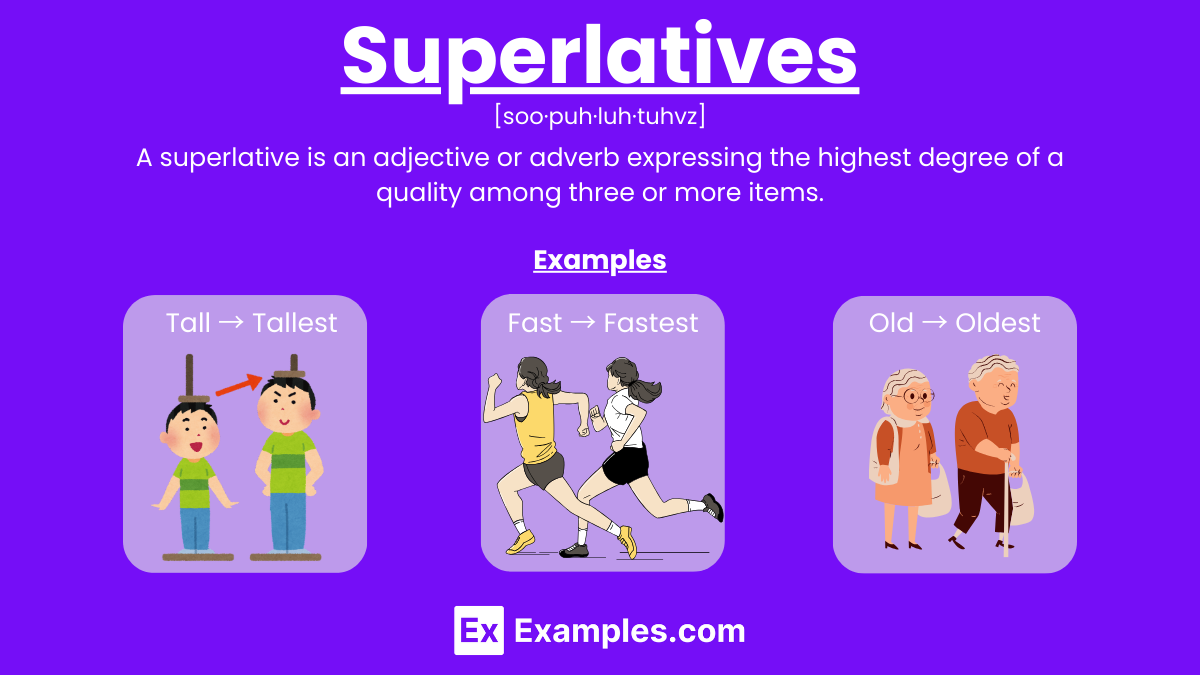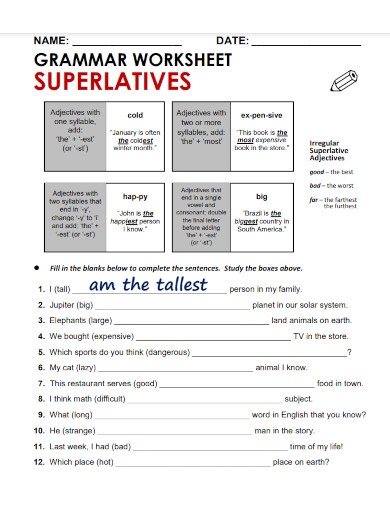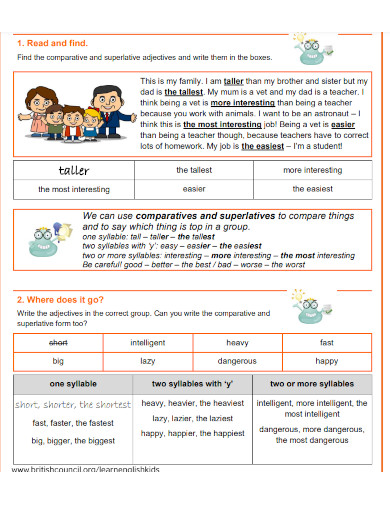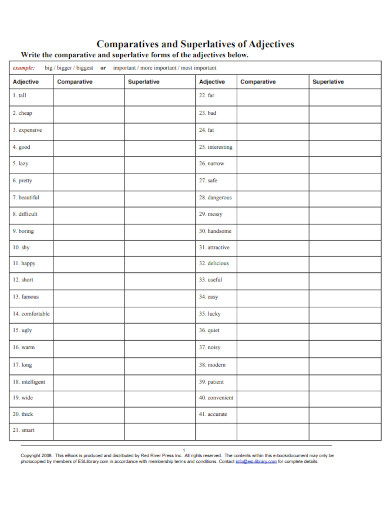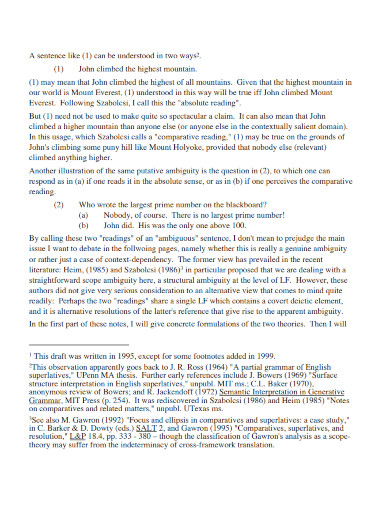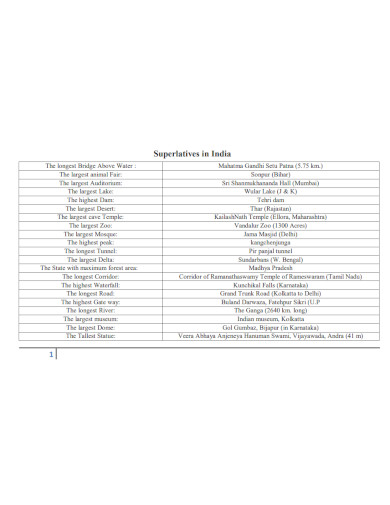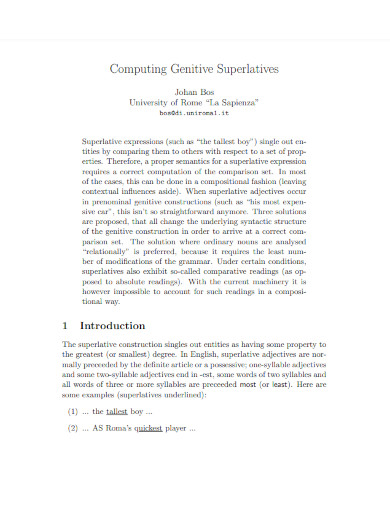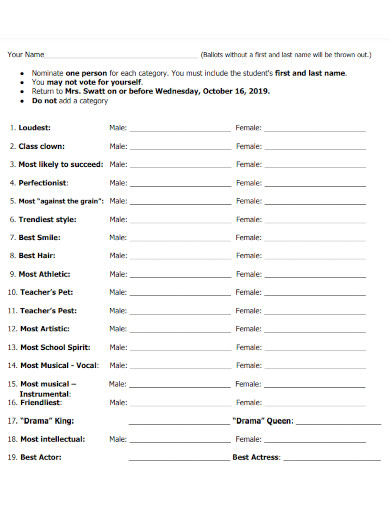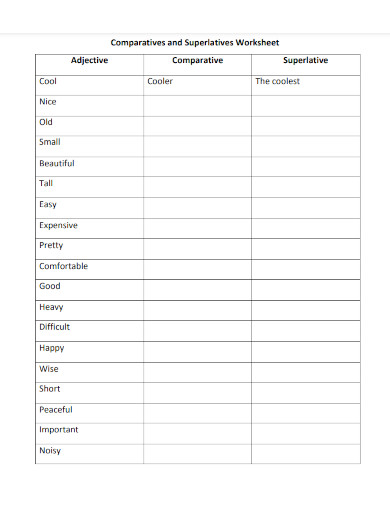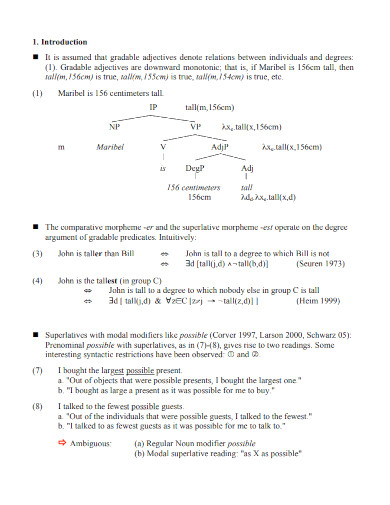120+ Superlatives Examples
Superlatives can be a useful tool in writing to emphasize the highest degree of a quality or attribute. They are used to make comparisons and to describe something as the most, best, worst, fastest, or any other extreme. Superlatives help to create vivid description that can evoke strong emotions in readers and make writing more interesting and engaging.
However, it is important to use superlatives judiciously and sparingly, as overuse can lead to exaggeration and reduce their impact. Additionally, it is crucial to ensure that superlatives are accurate and based on facts rather than personal biases or opinions.
What Are Superlatives?
Superlatives are adjectives or adverbs used to describe the highest degree or extreme of a quality among three or more items. They often end in “-est” (e.g., tallest) or use “most” before the adjective or adverb (e.g., most beautiful). Superlatives compare one thing to all others in a group, highlighting its superiority.
Types of Superlatives
Superlatives are used to indicate the highest degree of comparison among three or more things. Here are the different types of superlatives:
1. Adjective Superlatives
- Formed by Adding -est: For short adjectives (usually one syllable), add -est to the end.
- Example: “tall” → “tallest”
- Using “Most”: For longer adjectives (usually two syllables or more), use “most” before the adjective.
- Example: “beautiful” → “most beautiful”
- Irregular Forms: Some adjectives have irregular superlative forms.
- Example: “good” → “best”, “bad” → “worst”
2. Adverb Superlatives
- Formed by Adding -est: For short adverbs, add -est to the end.
- Example: “fast” → “fastest”
- Using “Most”: For longer adverbs, use “most” before the adverb.
- Example: “quickly” → “most quickly”
- Irregular Forms: Some adverbs have irregular superlative forms.
- Example: “well” → “best”, “badly” → “worst”
3. Noun Superlatives
- Most + Noun: Used to describe the highest degree of a noun.
- Example: “He has the most books in the class.”
4. Verb Superlatives
- While verbs themselves don’t have superlative forms, adverbs can modify them to indicate the highest degree.
- Example: “She runs the fastest in the team.”
5. Superlative Phrases
- Most + Adjective + Noun: Used to describe the highest degree of a characteristic.
- Example: “He is the most talented musician I know.”
List of Superlatives
Here is a comprehensive list of superlatives for adjectives, adverbs, and some irregular forms:
Adjective Superlatives
Regular Forms
- Short Adjectives (one syllable)
- tall → tallest
- small → smallest
- bright → brightest
- cold → coldest
- strong → strongest
- Adjectives ending in -y (change y to i and add -est)
- happy → happiest
- busy → busiest
- easy → easiest
- funny → funniest
- lazy → laziest
- Long Adjectives (two or more syllables)
- beautiful → most beautiful
- intelligent → most intelligent
- interesting → most interesting
- expensive → most expensive
- comfortable → most comfortable
Irregular Forms
- good → best
- bad → worst
- far → farthest/furthest
- little → least
- much/many → most
Adverb Superlatives
Regular Forms
- Short Adverbs
- fast → fastest
- hard → hardest
- late → latest
- soon → soonest
- Long Adverbs (using “most”)
- quickly → most quickly
- easily → most easily
- carefully → most carefully
- beautifully → most beautifully
- effectively → most effectively
Irregular Forms
- well → best
- badly → worst
- far → farthest/furthest
- much → most
- little → least
Noun Superlatives
- many → most
- few → fewest
- much → most
- little → least
Superlative Phrases
- Most + Adjective + Noun
- He is the most talented artist I know.
- This is the most exciting book I’ve ever read.
- She is the most dedicated employee in the company.
- That was the most delicious meal I’ve ever had.
- It was the most thrilling experience of my life.
Examples of Superlatives:
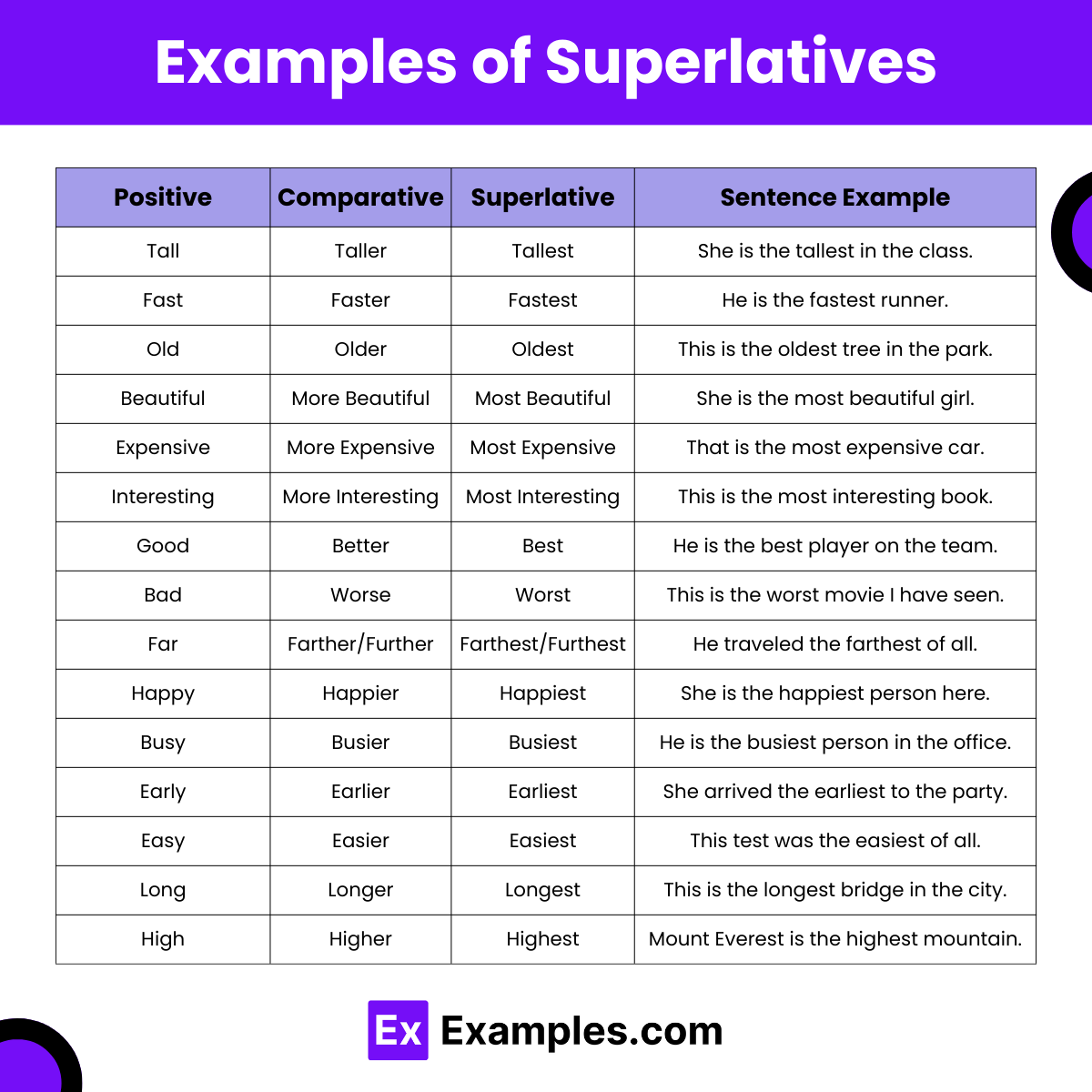
Superlatives Sentence Examples
Superlative adjectives express the highest degree of a quality among three or more items. They often end in “-est” or are preceded by “most.” Here are some examples of sentences using superlatives:
1. Single-word Superlatives:
- The tallest building in the city is the Empire State Building.
- She is the smartest student in the class.
- This is the most expensive car in the showroom.
- He is the oldest member of the team.
- Mount Everest is the highest mountain in the world.
2. Superlatives with “Most”:
- This is the most beautiful painting I have ever seen.
- She is the most talented musician in the orchestra.
- The Amazon is the most dangerous river to navigate.
- He has the most interesting job in the company.
- This is the most delicious cake I’ve ever tasted.
3. Irregular Superlatives:
- She is the best dancer in the troupe.
- He is the worst player on the team.
- That was the farthest he had ever traveled.
- This is the least expensive option available.
- He is the eldest of the three brothers.
4. Superlatives in Comparison:
- Of all the students, Mary is the most diligent.
- Among all the countries I’ve visited, Japan is the cleanest.
- Out of all the books I’ve read, this one is the most captivating.
- Of all the sports, football is the most popular.
- Among her friends, she is the kindest.
5. Superlatives with Time:
- This is the coldest winter in years.
- He gave the longest speech of the evening.
- That was the fastest race she has ever run.
- This is the earliest we have ever arrived.
- It was the latest he had ever stayed up.
6. Superlatives with Places:
- The Sahara is the hottest desert in the world.
- Antarctica is the coldest place on Earth.
- Paris is the most romantic city in Europe.
- The Nile is the longest river in Africa.
- The Grand Canyon is the deepest canyon in the USA.
Superlatives Examples for Teachers
Superlatives are useful in the classroom to compare students, teaching methods, resources, and more. Here are some examples of sentences using superlatives tailored for teachers:
1. Student Achievements:
- Maria is the most diligent student in our class.
- John wrote the longest essay in the entire grade.
- Sara received the highest score on the math test.
- Liam is the most creative student in art class.
- Emma submitted the best science project.
2. Classroom Activities:
- Today’s experiment was the most exciting we have done all year.
- That was the hardest quiz we’ve had so far.
- The field trip to the museum was the most educational experience for the students.
- Reading “Charlotte’s Web” was the most enjoyable activity this semester.
- The debate session was the most engaging class activity of the week.
3. Teaching Methods:
- Interactive lessons are the most effective teaching method for young learners.
- Using visual aids is the best way to explain complex concepts.
- Group projects are the most beneficial for developing teamwork skills.
- Storytelling is the most compelling technique for teaching history.
- Hands-on activities are the most interactive way to learn science.
4. Classroom Environment:
- This is the quietest class I have ever taught.
- Our new classroom is the brightest in the school.
- The library is the most peaceful place for studying.
- This year’s class is the most respectful group of students.
- The art room is the most colorful space in the building.
5. School Resources:
- The new smartboard is the most advanced technology in our school.
- Our library has the largest collection of books.
- The gymnasium is the biggest facility in the district.
- The science lab is the best equipped room in the school.
- The new cafeteria menu is the healthiest we have ever had.
6. Professional Development:
- The summer workshop was the most informative training session I attended.
- The guest lecture was the most inspiring talk this year.
- Online courses are the most convenient way to continue education.
- Peer reviews are the most constructive form of feedback.
- The annual conference is the best opportunity for networking.
Superlatives Examples for Work
Superlatives can effectively highlight achievements, qualities, and characteristics in the workplace. Here are some examples of sentences using superlatives tailored for a professional setting:
1. Employee Achievements:
- Sarah is the most dedicated employee in our department.
- John completed the largest project of the year.
- Emma received the highest performance rating in the team.
- Michael is the most innovative thinker in our company.
- Lucy has the best sales record this quarter.
2. Team Dynamics:
- Our team is the most collaborative in the organization.
- This team meeting was the most productive we’ve had.
- The marketing team is the most creative group in the office.
- Our project team is the most efficient in meeting deadlines.
- This is the most cohesive team I have ever worked with.
3. Company Performance:
- Our company achieved the highest revenue growth this year.
- This quarter has been the most profitable in the company’s history.
- We have the most loyal customer base in the industry.
- This product launch was the most successful we’ve ever had.
- Our brand is the most recognized in the market.
4. Work Environment:
- Our office has the best view in the building.
- The new lounge area is the most relaxing space in the office.
- This is the quietest workspace in the entire floor.
- The break room is the most popular spot during lunch hours.
- Our conference room is the most modern in the facility.
5. Professional Development:
- The recent training was the most informative session I’ve attended.
- She is the most qualified candidate for the promotion.
- This workshop was the most engaging professional development activity.
- The leadership program is the most comprehensive one offered.
- He is the most experienced member of our staff.
6. Project Management:
- This was the most challenging project we have tackled.
- The new software implementation was the most complex task this year.
- That campaign was the most demanding of all our initiatives.
- This is the fastest we have ever completed a project.
- The budget for this project is the largest we’ve ever managed.
Yearbook Superlatives Ideas
Yearbook superlatives are a fun way to highlight the unique qualities, talents, and quirks of students. Here are some creative superlative ideas:
1. Academic Achievements:
- Most Likely to Succeed
- Most Likely to Become a Professor
- Best at Math
- Best Writer
- Science Whiz
- Most Likely to Invent Something
2. Personality Traits:
- Most Likely to Brighten Your Day
- Best Smile
- Best Sense of Humor
- Most Outgoing
- Most Friendly
- Most Optimistic
3. Talents and Skills:
- Best Artist
- Best Musician
- Best Actor/Actress
- Most Athletic
- Best Dancer
- Future Rockstar
4. Style and Appearance:
- Best Dressed
- Best Hair
- Most Likely to Be on the Cover of Vogue
- Best School Spirit
- Most Unique Style
- Most Likely to Start a Fashion Trend
5. Social and Extracurricular Activities:
- Most Likely to Travel the World
- Most Involved
- Most Charitable
- Best Club Leader
- Most Likely to Become President
- Best Gamer
6. Miscellaneous Fun Superlatives:
- Class Clown
- Most Likely to Be Late to Graduation
- Most Likely to Be on a Reality Show
- Most Likely to Win an Oscar
- Most Likely to Become a Millionaire
- Most Likely to Stay in Touch
7. Creative and Unusual Superlatives:
- Most Likely to Break a World Record
- Best at DIY Projects
- Most Likely to Survive a Zombie Apocalypse
- Most Likely to Become an Internet Meme
- Most Likely to Win a Nobel Prize
- Most Likely to Have a Star Named After Them
Senior Superlatives Examples
Senior superlatives are a fun and memorable way to recognize the unique qualities and achievements of graduating students. Here are some classic and creative superlative ideas tailored for seniors:
1. Academic Achievements:
- Most Likely to Succeed
- Best at Math
- Best Writer
- Science Whiz
- Most Likely to Become a Professor
- Most Likely to Invent Something
2. Personality Traits:
- Best Smile
- Best Sense of Humor
- Most Outgoing
- Most Friendly
- Most Optimistic
- Most Likely to Brighten Your Day
3. Talents and Skills:
- Best Artist
- Best Musician
- Best Actor/Actress
- Most Athletic
- Best Dancer
- Future Rockstar
4. Style and Appearance:
- Best Dressed
- Best Hair
- Most Likely to Be on the Cover of Vogue
- Best School Spirit
- Most Unique Style
- Most Likely to Start a Fashion Trend
5. Social and Extracurricular Activities:
- Most Involved
- Most Charitable
- Best Club Leader
- Most Likely to Become President
- Best Gamer
- Most Likely to Travel the World
6. Future Predictions:
- Most Likely to Win an Oscar
- Most Likely to Become a Millionaire
- Most Likely to Stay in Touch
- Most Likely to Be Late to Graduation
- Most Likely to Be on a Reality Show
- Most Likely to Write a Bestselling Novel
7. Fun and Creative Superlatives:
- Class Clown
- Most Likely to Break a World Record
- Best at DIY Projects
- Most Likely to Survive a Zombie Apocalypse
- Most Likely to Become an Internet Meme
- Most Likely to Have a Star Named After Them
Funny Superlatives Examples
Adding humor to senior superlatives can make the yearbook even more memorable and entertaining. Here are some funny superlative ideas:
1. Personality and Quirks:
- Most Likely to Sleep Through an Earthquake
- Best Laugh
- Most Likely to Trip at Graduation
- Best Excuses for Being Late
- Most Likely to Have Their Own Reality Show
- Most Likely to Become a Meme
2. Social Media and Technology:
- Most Likely to Text in Class
- Most Likely to Post a Selfie Every Day
- Most Likely to Go Viral
- Most Likely to Have the Most Followers
- Best Snapchatter
- Most Addicted to Their Phone
3. Style and Appearance:
- Most Likely to Wear Pajamas to School
- Most Likely to Have a Wardrobe Malfunction
- Best Hair Day Every Day
- Most Unique Style
- Best Dressed… in the Dark
- Most Likely to Have the Messiest Locker
4. School and Academics:
- Most Likely to Ask for Extra Credit
- Most Likely to Have the Loudest Ringtone in Class
- Best at Sleeping in Class
- Most Likely to Have Their Homework Eaten by a Dog
- Most Likely to Write a Bestseller About Procrastination
- Most Likely to Bribe a Teacher
5. Sports and Activities:
- Most Likely to Forget Their Gym Clothes
- Best Benchwarmer
- Most Likely to Get Lost on the Way to Practice
- Most Likely to Cheer from the Sidelines
- Most Likely to Fake an Injury
- Most Likely to Bring Snacks to Practice
6. Future Predictions:
- Most Likely to Live in Their Parent’s Basement
- Most Likely to Marry a Celebrity
- Most Likely to Win the Lottery and Lose the Ticket
- Most Likely to Show Up Late to Their Own Wedding
- Most Likely to Forget Their Own Birthday
- Most Likely to Still Use Their High School ID for Discounts
7. Miscellaneous Fun:
- Most Likely to Start a Dance Party
- Best at Making Awkward Situations Even More Awkward
- Most Likely to Win a Hot Dog Eating Contest
- Most Likely to Become a Professional Napper
- Most Likely to Bring Home a Stray Animal
- Most Likely to Create a New Trend by Accident
Superlatives Examples for Adults
Superlatives can be a fun way to recognize and celebrate the unique qualities, achievements, and quirks of adults in various settings such as workplaces, social groups, or community events. Here are some superlative ideas tailored for adults:
1. Professional Achievements:
- Most Likely to Be CEO
- Best Dressed in the Office
- Most Likely to Work Overtime
- Most Innovative Thinker
- Best Team Player
- Most Likely to Start Their Own Business
2. Personality and Traits:
- Best Sense of Humor
- Most Likely to Brighten Your Day
- Most Energetic
- Best Storyteller
- Most Inspiring
- Most Positive Attitude
3. Talents and Skills:
- Best Chef
- Best DIY Expert
- Most Artistic
- Best at Multitasking
- Most Tech-Savvy
- Best at Solving Problems
4. Social and Lifestyle:
- Most Likely to Host a Great Party
- Best Travel Stories
- Most Likely to Know All the Gossip
- Best Workout Enthusiast
- Most Likely to Volunteer
- Best Home Decorator
5. Future Predictions:
- Most Likely to Write a Book
- Most Likely to Travel the World
- Most Likely to Retire Early
- Most Likely to Become a Public Speaker
- Most Likely to Adopt a Pet
- Most Likely to Be Famous
6. Fun and Creative Superlatives:
- Most Likely to Win a Cooking Competition
- Most Likely to Survive a Zombie Apocalypse
- Best at Finding a Bargain
- Most Likely to Be Late to Their Own Event
- Most Likely to Create a Viral Trend
- Best at Karaoke
High school Superlatives Examples
High school superlatives are a cherished part of yearbooks, celebrating the unique qualities and achievements of students. Here are some classic and creative superlative ideas tailored for high school students:
1. Academic Achievements:
- Most Likely to Succeed
- Best at Math
- Best Writer
- Science Whiz
- Most Likely to Become a Professor
- Most Likely to Invent Something
2. Personality Traits:
- Best Smile
- Best Sense of Humor
- Most Outgoing
- Most Friendly
- Most Optimistic
- Most Likely to Brighten Your Day
3. Talents and Skills:
- Best Artist
- Best Musician
- Best Actor/Actress
- Most Athletic
- Best Dancer
- Future Rockstar
4. Style and Appearance:
- Best Dressed
- Best Hair
- Most Likely to Be on the Cover of Vogue
- Best School Spirit
- Most Unique Style
- Most Likely to Start a Fashion Trend
5. Social and Extracurricular Activities:
- Most Involved
- Most Charitable
- Best Club Leader
- Most Likely to Become President
- Best Gamer
- Most Likely to Travel the World
6. Future Predictions:
- Most Likely to Win an Oscar
- Most Likely to Become a Millionaire
- Most Likely to Stay in Touch
- Most Likely to Be Late to Graduation
- Most Likely to Be on a Reality Show
- Most Likely to Write a Bestselling Novel
7. Fun and Creative Superlatives:
- Class Clown
- Most Likely to Break a World Record
- Best at DIY Projects
- Most Likely to Survive a Zombie Apocalypse
- Most Likely to Become an Internet Meme
- Most Likely to Have a Star Named After Them
College Superlatives Examples
College superlatives are a fun way to celebrate the unique qualities, achievements, and quirks of students. Here are some superlative ideas tailored for a college setting:
1. Academic Achievements:
- Most Likely to Become a Professor
- Most Likely to Win a Nobel Prize
- Best Researcher
- Most Likely to Publish a Paper
- Best Study Buddy
- Most Likely to Pull an All-Nighter
2. Personality Traits:
- Best Sense of Humor
- Most Likely to Brighten Your Day
- Most Outgoing
- Best Shoulder to Cry On
- Most Likely to Be Found in the Library
- Most Likely to Start a Conversation with a Stranger
3. Talents and Skills:
- Best Artist
- Best Musician
- Best Actor/Actress
- Most Athletic
- Best Dancer
- Most Likely to Start a Band
4. Style and Appearance:
- Best Dressed
- Best Hair
- Most Likely to Be on the Cover of Vogue
- Most Unique Style
- Best Accessorizer
- Most Likely to Wear Pajamas to Class
5. Social and Extracurricular Activities:
- Most Involved in Campus Activities
- Best Club President
- Most Charitable
- Best Party Host
- Most Likely to Join the Peace Corps
- Most Likely to Be a Social Media Influencer
6. Future Predictions:
- Most Likely to Become a CEO
- Most Likely to Travel the World
- Most Likely to Write a Bestselling Novel
- Most Likely to Become a Millionaire
- Most Likely to Stay in Touch
- Most Likely to Be on a Reality Show
7. Fun and Creative Superlatives:
- Class Clown
- Most Likely to Break a World Record
- Best at DIY Projects
- Most Likely to Survive a Zombie Apocalypse
- Most Likely to Become an Internet Meme
- Most Likely to Have a Star Named After Them
More Superlatives Templates & Examples:
1. Grammar Worksheet Superlatives
2. Comparatives and Superlatives Template
3. Comparatives and Superlatives of Adjectives
4. Notes on Superlatives Example
5. Superlatives in India Template
6. Computing Genitive Superlatives
7. Office Superlatives Template
8. Senior Superlatives Form
9. Comparatives and Superlatives Worksheet
10. Decomposing Modal Superlatives
Rules of Superlatives
Superlatives are used to express the highest degree of a quality among three or more items. Here are the key rules and guidelines for forming and using superlatives in English:
1. Forming Regular Superlatives:
- One-Syllable Adjectives:
- Add -est to the end of the adjective.
- Example: tall → tallest
- Example: fast → fastest
- Add -est to the end of the adjective.
- Two-Syllable Adjectives Ending in -y:
- Change the -y to -iest.
- Example: happy → happiest
- Example: busy → busiest
- Change the -y to -iest.
- Two-Syllable Adjectives Not Ending in -y and Longer Adjectives:
- Use most before the adjective.
- Example: beautiful → most beautiful
- Example: comfortable → most comfortable
- Use most before the adjective.
2. Irregular Superlatives:
- Some adjectives have irregular superlative forms that must be memorized.
- Example: good → best
- Example: bad → worst
- Example: far → farthest or furthest
3. Using Superlatives in Sentences:
- Superlatives are typically used with the definite article the.
- Example: She is the smartest student in the class.
- Example: Mount Everest is the highest mountain in the world.
4. Superlatives with Plural Nouns:
- When comparing more than one item within a group, use the superlative form.
- Example: These are the most expensive shoes in the store.
- Example: They are the best players on the team.
5. Negative Superlatives:
- To form a negative superlative, use least instead of most.
- Example: This is the least interesting book I have ever read.
- Example: He is the least experienced member of the team.
6. Superlatives with Adverbs:
- For adverbs, use most or least.
- Example: She sings the most beautifully.
- Example: He works the least efficiently.
7. Comparative vs. Superlative:
- Use the comparative form when comparing two items.
- Example: She is taller than her sister.
- Example: This movie is better than the last one.
- Use the superlative form when comparing three or more items.
- Example: She is the tallest of the three sisters.
- Example: This is the best movie I have seen.
Why Superlatives Are Important
Superlatives are a key component of language and communication, providing several important functions:
1. Highlighting Extremes:
- Superlatives express the highest degree of a quality among three or more items.
- They help identify and emphasize the most significant characteristics or achievements.
- Example: She is the fastest runner on the team.
2. Making Comparisons Clear:
- Superlatives clarify distinctions by comparing more than two items.
- They simplify understanding by showing the ultimate level of comparison.
- Example: This is the most interesting book in the series.
3. Enhancing Communication:
- Superlatives add emphasis and vividness to descriptions.
- They make communication more engaging and expressive.
- Example: It was the hottest day of the year.
4. Providing Specific Information:
- Superlatives give precise information about the highest or lowest degree of a quality.
- They help in making informed decisions by highlighting key differences.
- Example: He bought the cheapest car available.
5. Motivating and Recognizing Achievements:
- Superlatives acknowledge outstanding performance and qualities.
- They can boost morale and motivation by recognizing exceptional achievements.
- Example: She received the award for the best student.
6. Aiding in Marketing and Persuasion:
- Superlatives are often used in advertising and persuasion to emphasize superiority.
- They attract attention and persuade consumers by highlighting the best features.
- Example: Our product is the most effective on the market.
7. Creating Memorable Impressions:
- Superlatives make descriptions more memorable by emphasizing the highest degree.
- They leave a lasting impression by highlighting extreme qualities.
- Example: That was the most exciting game I’ve ever watched.
8. Facilitating Storytelling:
- Superlatives enhance storytelling by emphasizing the most notable aspects.
- They make stories more compelling and engaging by highlighting extremes.
- Example: It was the coldest winter in decades.
How to write Superlatives?
Superlatives are adjectives or adverbs used to express the highest degree of a quality among three or more items. Here’s a guide on how to write superlatives correctly:
1. Understanding Superlatives:
- Superlatives compare one item to all others in a group, indicating the extreme quality of that item.
- Usage: They are used to describe the highest or lowest degree of a quality.
2. Forming Superlative Adjectives:
- One-Syllable Adjectives:
- Add -est to the end of the adjective.
- Example: tall → tallest
- Sentence: She is the tallest student in the class.
- Two-Syllable Adjectives Ending in -y:
- Change the -y to -iest.
- Example: happy → happiest
- Sentence: He is the happiest person I know.
- Two-Syllable Adjectives Not Ending in -y and Longer Adjectives:
- Use most or least before the adjective.
- Example: beautiful → most beautiful
- Sentence: This is the most beautiful painting in the gallery.
3. Forming Superlative Adverbs:
- One-Syllable Adverbs:
- Add -est to the end of the adverb.
- Example: fast → fastest
- Sentence: She runs the fastest.
- Longer Adverbs:
- Use most or least before the adverb.
- Example: gracefully → most gracefully
- Sentence: She dances the most gracefully.
4. Irregular Superlatives:
- Some adjectives and adverbs have irregular superlative forms that must be memorized.
- Example: good → best
- Sentence: He is the best player on the team.
- Example: bad → worst
- Sentence: This is the worst movie I’ve seen.
5. Using Superlatives in Sentences:
- Definite Article “The”:
- Superlatives are typically used with the definite article the.
- Example: She is the smartest student in the class.
- Comparative Context:
- Ensure that the superlative clearly indicates the comparison among three or more items.
- Example: Mount Everest is the highest mountain in the world.
6. Negative Superlatives:
- Use least to form negative superlatives, indicating the lowest degree of a quality.
- Example: This is the least interesting book I have ever read.
Superlatives vs. Comparatives
The table below summarizes the key differences between superlatives and comparatives, including their formation and usage:
| Feature | Comparatives | Superlatives |
|---|---|---|
| Definition | Compare two items | Compare three or more items |
| Formation (One-Syllable Adjectives) | Add -er | Add -est |
| Example (One-Syllable) | tall → taller | tall → tallest |
| Sentence (One-Syllable) | She is taller than her brother. | She is the tallest in the class. |
| Formation (Two-Syllable Adjectives Ending in -y) | Change -y to -ier | Change -y to -iest |
| Example (Two-Syllable -y) | happy → happier | happy → happiest |
| Sentence (Two-Syllable -y) | She is happier than before. | She is the happiest person here. |
| Formation (Longer Adjectives) | Use more or less before the adjective | Use most or least before the adjective |
| Example (Longer Adjectives) | beautiful → more beautiful | beautiful → most beautiful |
| Sentence (Longer Adjectives) | She is more beautiful than her sister. | She is the most beautiful of all. |
| Irregular Forms | good → better, bad → worse | good → best, bad → worst |
| Sentence (Irregular) | She is a better player than him. | She is the best player on the team. |
| Usage | Used to highlight differences between two items | Used to indicate the extreme quality among three or more items |
| Definite Article | Not typically used | Typically used with the |
| Negative Forms | Use less before the adjective | Use least before the adjective |
| Example (Negative) | interesting → less interesting | interesting → least interesting |
| Sentence (Negative) | This book is less interesting than that one. | This is the least interesting book of all. |
How to use Superlatives
Examples of superlatives include “the best,” “the worst,” “the most,” “the least,” “the fastest,” “the slowest,” and so on. They are often formed by adding “-est” to an adjective (such as “brightest” or “smallest”) or using the words “most” or “least” before the adjective (such as “most beautiful” or “least attractive”).
Step 1: Use superlatives sparingly
Overusing superlatives can reduce their impact and make your writing seem less credible, especially in blogs and slogans. Use them only when necessary and make sure they accurately reflect the degree of comparison.
Step 2: Choose accurate superlatives
Be sure to choose superlatives that accurately reflect the degree of comparison. Avoid exaggeration and hyperbole that could make your writing seem less credible.
Step 3: Vary your superlatives
Instead of using the same superlatives repeatedly, try to vary them to add interest and variety to your writing. Use a thesaurus to find synonyms for common superlatives.
Step 4: Use superlatives to create vivid descriptions
Superlatives can be used to create vivid descriptions that help readers visualize and understand your writing. For example, “The largest waterfall in the world,” is a more vivid description than “A very big waterfall.”
Step 5: Use superlatives to emphasize key points
Superlatives can be used to emphasize key points in your writing and draw the reader’s attention to important information. For example, “The most important factor in a healthy lifestyle is regular exercise.”
What is a superlative?
A superlative is a form of an adjective or adverb used to express the highest degree of a quality among three or more items.
How do you form superlatives?
For one-syllable adjectives, add “-est.” For two-syllable adjectives ending in -y, change -y to -iest. Use “most” or “least” for longer adjectives.
What are examples of irregular superlatives?
Common irregular superlatives include “good” → “best,” “bad” → “worst,” and “far” → “farthest” or “furthest.”
When do you use superlatives?
Use superlatives when comparing three or more items to show which one has the highest or lowest degree of a certain quality.
Do superlatives always use “the”?
Yes, superlatives typically use “the” before the adjective or adverb to indicate that it is the highest or lowest degree.
Can you give examples of superlative sentences?
“She is the smartest student in the class.” “This is the most beautiful painting in the gallery.”
What’s the difference between comparatives and superlatives?
Comparatives compare two items (e.g., taller), while superlatives compare three or more items (e.g., tallest).
Are there negative superlatives?
Yes, negative superlatives use “least” to indicate the lowest degree of a quality, like “least interesting.”
How do superlatives enhance writing?
Superlatives add emphasis and clarity by highlighting the extreme degree of a quality, making descriptions more vivid and engaging.
Can adverbs be superlatives?
Yes, adverbs can be superlatives. For example, “She runs the fastest” or “He sings the most beautifully.



